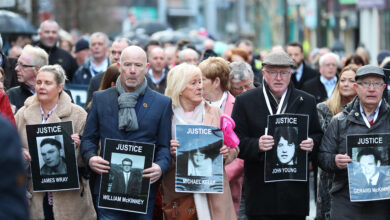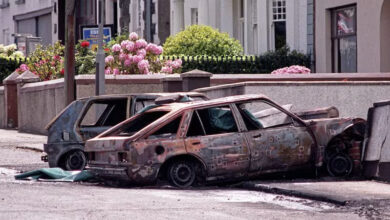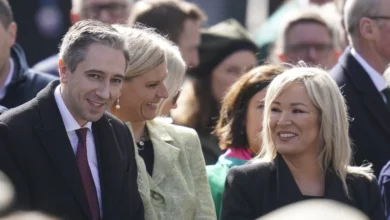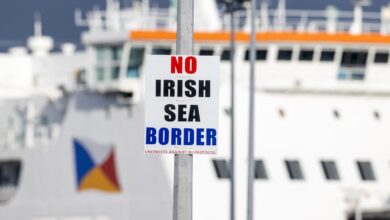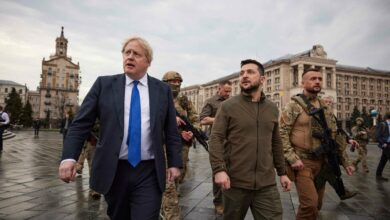Massereene Trial: in aula il filmato dell’attacco della Real IRA
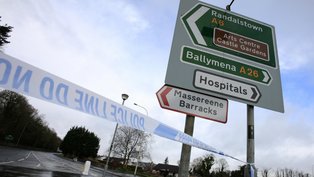
CCTV footage at Massereene trial
The Massereene murder trial at Antrim Crown Court has been shown CCTV pictures of the moment two soldiers were shot dead at the base as they collected a pizza delivery.
 Sappers Patrick Azimkar, 21, and Mark Quinsey, 23, were killed by the Real IRA outside the military base on 7 March 2009.
Sappers Patrick Azimkar, 21, and Mark Quinsey, 23, were killed by the Real IRA outside the military base on 7 March 2009.
A number of others were injured in the attack including three soldiers, a security guard and pizza delivery men.
High profile republican Colin Duffy, aged 43 and from Forest Glade in Lurgan, and 46-year-old Brian Shivers, from Sperrin Mews in Magherafelt, deny the murder charges and six further counts of attempted murder.
As the hearing opened, the murdered soldiers’ mothers – Mrs Azimkar and Mrs Quinsey – comforted each other.
The grieving families, wearing remembrance poppies, sat on one side of the accused men while relatives of the defendants sat on the opposite side.
Shivers, who is on bail because he suffers from cystic fibrosis, wore jeans and a dark coat.
Duffy, escorted into the court by prison officers, smiled and gave a thumbs-up to his family.
He is being held on remand at Maghaberry prison in Co Antrim, where he is presently involved in a so-called “no wash” protest.
Opening the Crown’s case on Monday, Terence Mooney QC told how the habit of collecting pizzas at the gates of the base had left the troops vulnerable to attack.
“On 7 March 2009, a surprise and murderous attack was carried out by terrorists using automatic assault rifles,” he said.
“The targets were unsuspecting and utterly defenceless soldiers and civilians who were gathered at the entrance gates to the base.
“The nature of the attack and the manner in which it was executed bears the unmistakable stamp of a highly organised and ruthless terrorist attack.”
He suggested to the court that relatives of the murdered soldiers might wish to leave prior to the screening of the footage of the shootings. Both grieving mothers chose to leave.
Mr Mooney played footage to the courtroom which showing five soldiers walk out of the base to meet pizza delivery cars.
Dressed in the desert combat gear, the troops from the 38 Engineer Regiment were only hours away from being deployed to Afghanistan.
Two masked men then appeared, opening fire on both the soldiers and the fast-food delivery workers, before pausing to aim at what the prosecution said was wounded men lying on the ground.
CCTV pictures also showed that 65 rounds were fired in the attack which lasted around one minute.
Mr Mooney said a soldier injured in the attack recounted how he was pushed to the ground by his colleague Patrick Azimkar, who was subsequently murdered.
Mr Mooney said a pathologist’s report showed the soldiers killed in the shootings suffered multiple bullet and shrapnel wounds.
An audio clip was also played by Mr Mooney of a voice message said to have been accidentally left on a mobile phone.
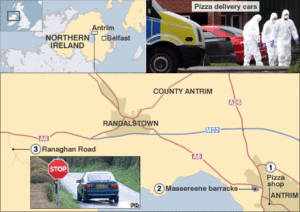 The phone was found in a green Vauxhall car, believed to have been the getaway vehicle.
The phone was found in a green Vauxhall car, believed to have been the getaway vehicle.
“The message is chilling and self-explanatory,” he told the judge, Mr Justice Anthony Hart.
The court then heard a male voice which said: “There were a few dead all right.”
Expert analysis had, said Mr Mooney, linked the images of the getaway car to a vehicle found by police on a quiet country road seven miles from the scene.
Mr Mooney said the green Vauxhall Cavalier had been sold privately by its former owner through an advertisement in a magazine.
The owner told investigators he had cleaned the car and wiped its surfaces prior to putting it up for sale.
Video footage from a petrol station was shown which is said to have been filmed after the car was purchased. It shows a man putting petrol in the car and paying for it.
Mr Mooney asked the judge to note that the man did not wear gloves.
When the car was found after the shooting, at the junction of the Derrygowan and Ranaghan roads, it had been damaged by fire in what the court heard may have been an attempt to destroy it.
Inside the car, a coffee jar containing bullets – of the same calibre used in the attack – was discovered. Two mobile phones were found between the front seats and clothing, balaclavas and a camouflage holdall were found in the boot.
The court was shown photographs of a red petrol container found on a grass verge. A black plastic lid was also recovered and a matchstick was found on the roadside.
Mr Mooney said the rounds of ammunition found originated in Yugoslavia and were for use in assault weapons.
The tip of a latex glove was found on the floor of the vehicle the tip of which Mr Mooney said was linked to Duffy by DNA testing.
He also said DNA tests linked Shivers to a matchstick and a mobile phone.
But, a defence lawyer objected to the prosecution presentation of the evidence against Duffy saying that the prosecution was leaving open the possibility of one of a number of scenarios around Duffy’s alleged link to the killing, which may affect his defence.
Mr Mooney said that on the basis of the evidence, it was not suggested that Colin Duffy was one of the gunmen.
He said the evidence set the accused in the position of being part of a joint enterprise that led to the killing of the two soldiers.
The trial is set to be one of Northern Ireland’s biggest in recent years, lasting up to five weeks.

